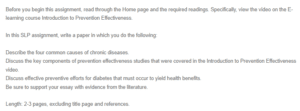Infectious and Chronic Diseases
The Four Common Causes of Chronic Diseases
Most chronic diseases are caused by several factors, but the main ones include the use of tobacco and exposure to second-hand smoke; poor nutrition such as foods that are high in saturated fats and sodium including diets that are low in vegetables and fruits; failure to engage in physical activity; and excessive alcohol intake (Cockerham, Hamby, & Oates, G. R. 2017).
The Key Components of Prevention Effectiveness Studies
Prevention effectiveness refers to the systematic assessment that the practices, programs, and policies in health have on health outcomes by determining how effective they are as well as their costs and safety. Decision analyses is used as well as modeling techniques in prevention effectiveness by providing information for making decisions on resource allocation and policy formulation in public health (Schmidt, 2016). Do you need help with your assignment ? Get in touch with us at eminencepapers.com.
Prevention effectiveness studies assess the impact that practices, programs, and policy evaluations have on healthcare resources’ allocation and provide decision-makers with the information they need to take action. The studies also focus on the strategies’ life cycle, which includes doing basic research to determine if the prevention is plausible, applied research to determine the efficacy of the prevention strategy, community demonstration to check the effectiveness of the strategies, and implementation where the continuity of the strategies is analyzed (CDC, 2014).
Effective Preventive Efforts for Diabetes That Must Occur to Yield Health Benefits
According to Agha et al. (2016), eating foods that are sugar-laden and filled with refined carbs can place one at risk of developing diabetes. The body breaks these foods rapidly into small sugar molecules that are then absorbed very fast in the bloodstream. This results in a spike in blood sugar, which then stimulates the pancreas to produce insulin hormone. In persons that have peri-diabetes, the cells become resistant to the action of insulin; hence, blood sugar remains in large volumes. To counter this inaction, the body produces more insulin in an attempt to reduce the level of blood sugar to healthier levels. Hence, a person needs to reduce or completely eliminate refined carbohydrates and sugary foods to prevent diabetes.
Performing physical activities is another preventive measure for diabetes. A sedentary lifestyle can contribute to excessive weight gain. When one exercises, the sensitivity to insulin in the cells is increased. Hence, as a person exercises, the body requires less insulin to control the levels of blood sugar in the body. Additionally, a person needs to take plenty of water as this is a natural beverage that has numerous benefits to the body. Drinking water helps one avoid drinking unhealthy, sugary beverages. Sugary beverages such as punch and soda have been linked to increasing the risk of Type II Diabetes.
Although not all persons who are overweight or obese develop diabetes, most people do. Additionally, persons with pre-diabetes often have excess weight around the abdomen and midsection, referred to as visceral fat. Excessive visceral fat promotes resistance to insulin and inflammation, which in turn increases the risk of diabetes significantly. Weight loss is another way that a person can avert the onset of diabetes.
Smoking is one of the leading causes of preventable deaths as it contributes to a number of illnesses, including lung and throat cancer, heart disease, and emphysema, among others. Second-hand smoke has been linked to type II diabetes as well. Hence, a person can prevent diabetes by smoking cessation and also eliminating second-hand exposure to others.
References
Agha-Jaffar, R., Oliver, N., Johnston, D., & Robinson, S. (2016). Gestational diabetes mellitus: does an effective prevention strategy exist?. Nature Reviews Endocrinology, 12(9), 533.
Centers for Disease Control and Prevention. (2014). E-learning course – Introduction to prevention effectiveness. Accessed from https://www.cdc.gov/publichealth101/e-learning/prevention-effectiveness/.
Cockerham, W. C., Hamby, B. W., & Oates, G. R. (2017). The social determinants of chronic disease.
Schmidt, H. (2016). Chronic disease prevention and health promotion. In Public health ethics: Cases spanning the globe (pp. 137-176). Springer, Cham.
ORDER A PLAGIARISM-FREE PAPER HERE
We’ll write everything from scratch
Question
Before you begin this assignment, read through the Home page and the required readings. Specifically, view the video on the E-learning course Introduction to Prevention Effectiveness.

Infectious and Chronic Diseases
In this SLP assignment, write a paper in which you do the following:
Describe the four common causes of chronic diseases.
Discuss the key components of prevention effectiveness studies that were covered in the Introduction to Prevention Effectiveness video.
Discuss effective preventive efforts for diabetes that must occur to yield health benefits.
Be sure to support your essay with evidence from the literature.
Length: 2-3 pages, excluding title page and references.

